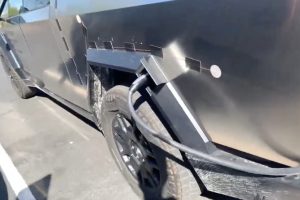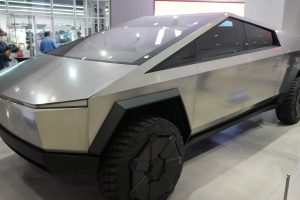- 🚗 Tesla introduced the first-ever Dry Cathode Cybertruck.
- 🛠️ The truck is equipped with in-house developed dry cathode 4680 cells.
- 📷 A photo was shared by Tesla’s Sr. Manufacturing Engineer Cole Otto on LinkedIn.
- 🏁 Vehicle testing for the Dry Cathode Cybertruck has already begun.
- 🖤 The vehicle showcased in the photo was wrapped in matte black.
- ✈️ Earlier images were also shared by Joe Tegtmeyer during a Giga Texas flyover.
- ✅ Bonne Eggleston confirmed on social media that the vehicle is the Dry Cathode Cybertruck.
- 🔧 Current Cybertrucks have 4680 cells with a dry electrode negative cathode and wet electrode positive cathode.
- 📅 Tesla aims to mass-produce complete dry electrode 4680 cells by the end of 2024.
- 🌟 Optimism exists around Tesla’s future with complete dry electrode cells altering the EV landscape.
In a stunning revelation, Tesla has introduced the first-ever Dry Cathode Cybertruck, marking a significant milestone in electric vehicle (EV) technology. With the unveiling of this groundbreaking advancement, Tesla continues to push the boundaries of innovation, reinforcing its position as a leader in the EV industry. Here’s an in-depth look at what makes this new development so exciting and its potential impact on the future of electric vehicles.
Unveiling the Dry Cathode Cybertruck
Tesla’s dry cathode technology is nothing short of revolutionary. The company has successfully integrated its in-house developed dry cathode 4680 cells into the iconic Cybertruck. This innovation is expected to significantly enhance both the performance and cost-efficiency of Tesla’s electric vehicles.
The Photo That Captured Attention
The announcement came to light through a LinkedIn post by Tesla’s Senior Manufacturing Engineer, Cole Otto. The shared photo showcased a sleek matte black Cybertruck, wrapping in ambiguity and innovation. The image depicted Otto’s team posing proudly with the engineering marvel, set against the backdrop of Tesla’s advanced technological prowess.
Early Sightings and Confirmations
Interestingly, this isn’t the first time the Dry Cathode Cybertruck has been spotted off the production lines. Noted Tesla enthusiast Joe Tegtmeyer had previously shared aerial images of the matte black vehicle during a flyover of Tesla’s Giga Texas facility. These initial sightings piqued curiosity and excitement among the EV community. Subsequently, Tesla’s Sr. Director of the 4680 program, Bonne Eggleston, confirmed via social media platform X that the mystery vehicle was indeed the Dry Cathode Cybertruck.
Technical Insights Into the 4680 Cells
Tesla’s current production of Cybertrucks utilizes 4680 cells, albeit with a twist. While equipped with a dry electrode negative cathode produced through Tesla’s proprietary process, the positive cathode still comes from an external supplier and employs a conventional wet electrode process. This hybrid approach has allowed Tesla to forge ahead while perfecting its dry electrode technology.
The Goal: Complete In-House 4680 Cells
Tesla’s roadmap includes the ambitious target of commencing mass production of complete dry electrode 4680 cells by the end of 2024. This foresight hinges on the dual development of both negative and positive cathodes using the in-house dry electrode process. The implications of achieving this milestone are profound. As one optimistic insider highlighted, “Once dry electrodes are developed, they can change Tesla.”
Potential Impact on the EV Landscape
The successful integration and mass production of complete dry electrode 4680 cells could dramatically revolutionize the electric vehicle market. Here’s why:
- Enhanced Performance: The dry cathode technology promises superior energy density and faster charging times, potentially increasing vehicle range and usability.
- Cost Efficiency: By manufacturing both electrodes in-house, Tesla can significantly reduce production costs, making electric vehicles more affordable for consumers.
- Environmental Benefits: Dry electrode processes are generally more environmentally friendly compared to traditional wet electrode techniques, aligning with Tesla’s vision of sustainability.
The Road Ahead
As Tesla prepares to scale up the production of its complete dry electrode 4680 cells, the Dry Cathode Cybertruck stands as a beacon of the company’s innovative spirit. Vehicle testing has commenced, and the excitement surrounding this development is palpable.
Conclusion
Tesla’s introduction of the first-ever Dry Cathode Cybertruck is a landmark achievement in the EV sector. As the company ventures into mass production of advanced 4680 cells, the potential to transform electric vehicle technology is enormous. This innovation not only showcases Tesla’s commitment to pushing the boundaries of performance and sustainability but also sets the stage for a future where electric vehicles are more efficient, affordable, and eco-friendly.





